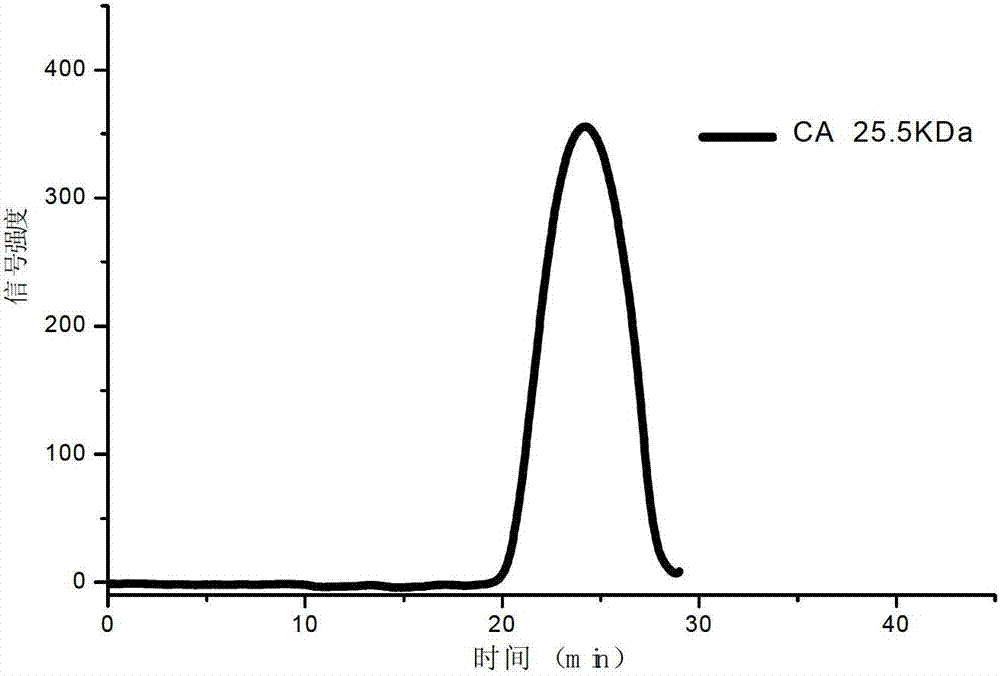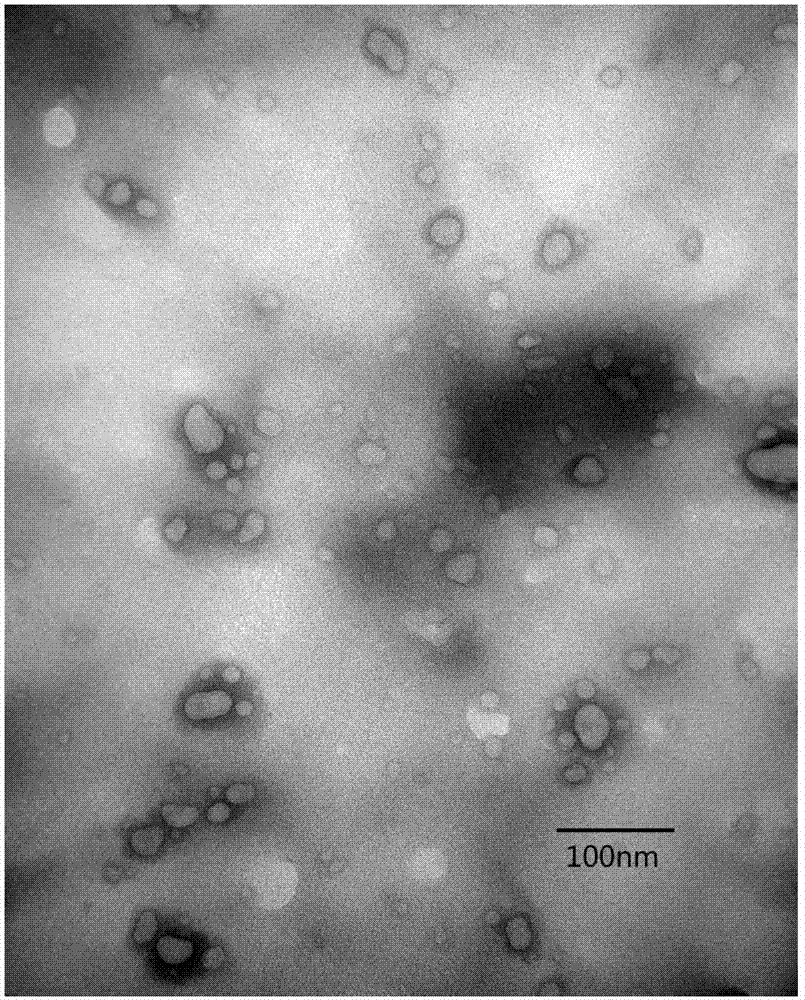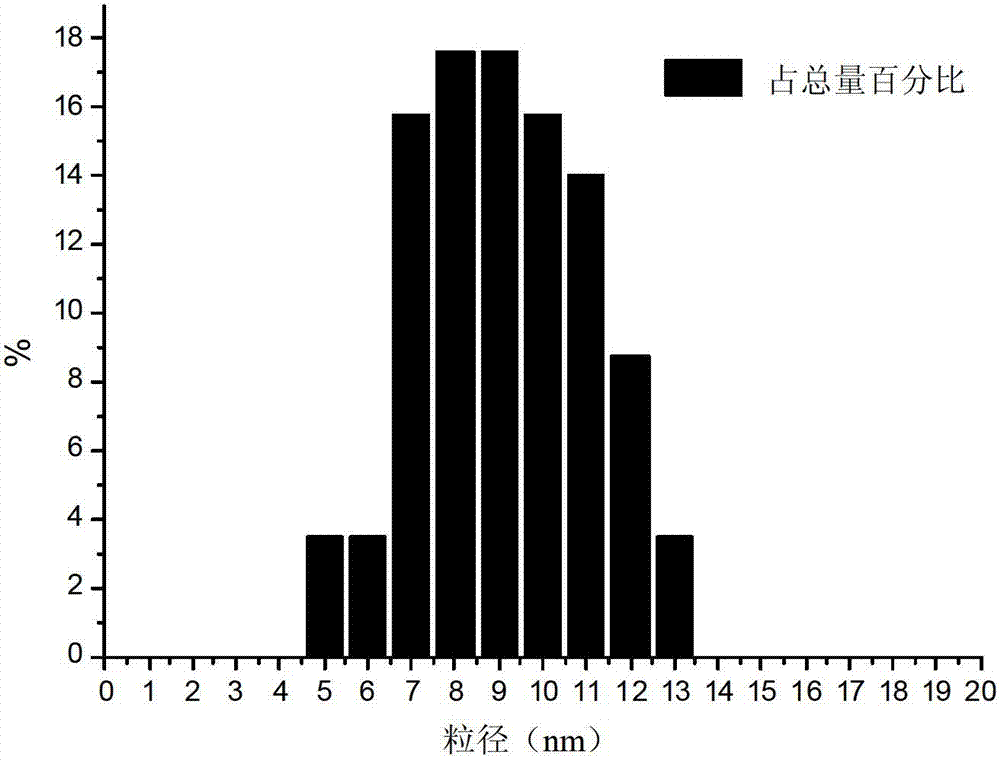Functional near-infrared fluorescence nanoparticles and preparation and application thereof
A fluorescent nanometer and infrared fluorescence technology, applied in the field of nanometer near-infrared fluorescent materials, can solve the problems of inactive groups that are not easily labeled with molecules, low fluorescence intensity, weak photostability, etc. Easy to disintegrate effect
- Summary
- Abstract
- Description
- Claims
- Application Information
AI Technical Summary
Problems solved by technology
Method used
Image
Examples
Embodiment 1
[0033] Preparation method of near-infrared fluorescent nanoparticles:
[0034] (1) Indocyanine Green (ICG) - chitosan (CA) electrostatic binding
[0035] Add ICG to 0.1M HAc / NaAc buffer solution (pH4.2), prepare 1mg / mL ICG solution, and remove a small amount of insoluble matter through 0.22μm filter membrane to obtain a solution. Use HAc / NaAc buffer solution (0.1M, pH 4.2) to prepare 5mg / mL chitosan solution, figure 1 It is the gel exclusion chromatography result of CA, and its molecular weight is calculated as 25.5kDa based on the standard curve obtained from the standard dextran, and it is treated with a 0.22μm filter membrane to obtain a solution. In the state of magnetic stirring, 50 μL of ICG solution was dropped into 2 mL of chitosan solution through a liquid inlet pump at a constant speed to prepare an ICG-CA electrostatic binding solution.
[0036](2) Preparation of indocyanine green (ICG)-chitosan (CA)-sodium polyphosphate (STPP) nanoparticles
[0037] Add sodium p...
Embodiment 2
[0041] Characterization of ICG-CA-STPP-ALG near-infrared fluorescent nanoparticles:
[0042] (1) Shape and size of ICG-CA-STPP-ALG near-infrared fluorescent nanoparticles
[0043] figure 2 It is a transmission electron microscope photo of ICG-CA-STPP-ALG near-infrared fluorescent nanoparticles. The results show that indocyanine green can form nanoparticles after being electrostatically wrapped by nanocarriers such as chitosan and sodium alginate, and the dispersion between nanoparticles Good performance, little condensation occurs. image 3 It is the particle size distribution of ICG-CA-STPP-ALG near-infrared fluorescent nanoparticles observed by electron microscope, and the statistical analysis results show that the particle size distribution of the nanoparticles is ~9nm. The particle size can be controlled by adjusting the ratio of CA to STPP, CA concentration, stirring speed, pump speed, etc.
[0044] (2) Effect of different concentrations of NaCl on the particle size o...
Embodiment 3
[0051] Imaging of mice using ICG-CA-STPP-ALG near-infrared fluorescent nanoparticles: After the mice were anesthetized with anesthesia, 7.5 μl / g of body weight of ICG was injected into the tail vein of the mice at a concentration of (83 μg / mL) ICG-CA -STPP-ALG near-infrared fluorescent nanoparticles, using a small animal in vivo imaging system to perform fluorescence imaging under the excitation of 770nm excitation light, the fluorescence imaging conditions are 780nm-950nm, the step size is 10nm, and the exposure time is 400ms. Figure 7 The left column is the fluorescence imaging images of nude mice at different time points after injection of free ICG, and the right column is the fluorescence imaging images of nude mice at different time points after injection of ICG-CA-STPP-ALG nanoparticles. It can be seen from the results that after 1 minute of injection of ICG-CA-STPP-ALG near-infrared fluorescent nanoparticles, the surface skin of the mouse emitted a stronger fluorescent ...
PUM
| Property | Measurement | Unit |
|---|---|---|
| particle diameter | aaaaa | aaaaa |
| particle size | aaaaa | aaaaa |
Abstract
Description
Claims
Application Information
 Login to View More
Login to View More - R&D
- Intellectual Property
- Life Sciences
- Materials
- Tech Scout
- Unparalleled Data Quality
- Higher Quality Content
- 60% Fewer Hallucinations
Browse by: Latest US Patents, China's latest patents, Technical Efficacy Thesaurus, Application Domain, Technology Topic, Popular Technical Reports.
© 2025 PatSnap. All rights reserved.Legal|Privacy policy|Modern Slavery Act Transparency Statement|Sitemap|About US| Contact US: help@patsnap.com



